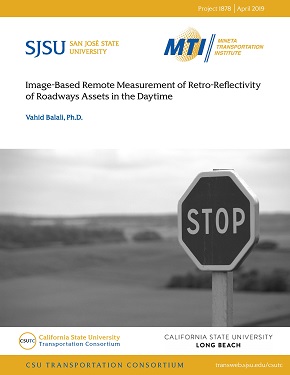- 408-924-7560
- mineta-institute@sjsu.edu
- Donate
Image-Based Remote Measurement of Retro-Reflectivity of Roadways Assets in the Daytime
One of the most effective and low-cost ways for improving nighttime driving safety of transportation systems is maintaining the traffic signs retro-reflectivity. The U.S. Federal Highway Administration (FHWA) has enacted new rules on the minimum level of retroreflectivity which compels agencies to measure the current levels of retro-reflectivity of traffic signs and develop plans for replacing or improving their condition. Current practices in assessing and measuring the retro-reflectivity of traffic signs, including handheld retroreflectometer and mobile technologies, are financially and practically infeasible because of their physical and technical constraints.
This research project explores and presents the possibility of an inexpensive, safe, and cost-effective computer vision method for remotely measuring the retro-reflectivity of traffic signs during daytime using High Dynamic Range (HDR) images. By capturing two images simultaneously during the daytime, the method simulates nighttime visibility for each sign and measures retro-reflectivity at a level of accuracy that is mandated by FHWA guidelines. The research project develops a remote retro-reflecto-meter that consists of a consumer-grade camera, flashlight, GPS receiver, and screen. An experimental test was conducted on different types of traffic signs with different levels of retro-reflectivity which are located at different distances in real-world conditions to validate the performance of the method. The results, compared with data collected from a standard retro-reflectometer, demonstrates the potential of the method in lowering costs, improving safety, perform during the daytime, and shorten time required for retro-reflectivity data collection.
The proposed technique is faster, cheaper, and safer compared to the state-of-the-art as neither requires nighttime operation nor manual sign inspection, particularly for overhanging signs which are hard to reach. The developed technique allows inspectors to carry around and measure retro-reflectivity levels during the daytime on foot. The technique can be mounted to and detached from a vehicle to be used by an inspector in the passenger seat. This study will provide an effective way for CalTrans to inspect and replace/repair defective signs and markings while avoiding expensive retro-reflecto-meters and nighttime visibility inspections. If CalTrans wants to implement the developed technology at a larger-scale, their research team will seek opportunities with CalTrans’ current vendors which aim to provide mobile asset management services to transfer the developed technology.
VAHID BALALI, PhD
PI Vahid Balali, PhD, is an Assistant Professor in the Department of Civil Engineering and Construction Engineering Management at California State University Long Beach. He is a member of National Center for Transportation, Green Technology, and Education (TransGET). Dr. Balali’s research focuses on the visual data sensing and analytics, virtual design and construction for civil infrastructure and interoperable system integration, and smart cities in transportation for sustainable decision-making. His research interests include experimental and computational approaches for image-based recognition, 3D localization, and retro-reflectivity evaluation of civil infrastructures for enhanced condition assessment. Through his research and work experience, he has been involved in several software and hardware developments that resulted in many research prototypes. He also has experience as a visual data analyst and developed a video-based construction resource tracking and action recognition for activity analysis of operators at Caterpillar. He has the knowledge, technical skills, and experience that are crucial to the successful completion of the proposed work.
He was selected as one of the Top 40 under 40 by the Consulting-Specifying-Engineer for the year 2017 and top young professional in California by the Engineering News Record (ENR) for the year 2016. He has received the 2014 second best poster award from the Construction Research Congress, and 2013 CMAA national capital chapter scholarship award. He is currently an associate member of ASCE and CMAA, committee member of the ASCE Data Sensing and Analysis and ASCE Visual Information Modeling and Simulation committees, and friend member of relevant TRB committees. He is also serving as a reviewer of several top-notch Journals. He is actively collaborating with industrial partners and is involved in professional and outreach activities.
-
Contact Us
San José State University One Washington Square, San Jose, CA 95192 Phone: 408-924-7560 Email: mineta-institute@sjsu.edu






